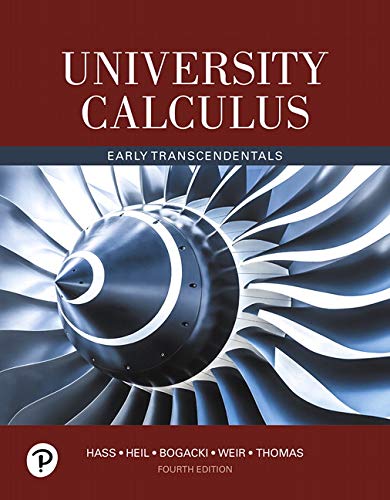
Concept explainers
Mention the rules for differentiating and integrating
Explanation of Solution
Description:
Rules for differentiating vector functions:
Consider,
u and v is the differentiable vector functions of t,
c is scalar,
C is a constant vector, and
f is differentiable scalar function.
1. Constant function rule:
2.
3.
4. Scalar multiple rule:
5. Chain rule:
6. Dot product rule:
7. Cross product rule:
For example:
Consider the position of a particle in the xy-plane
The position function is,
The expression for velocity of a particle is,
Substitute
At
The magnitude of the velocity
The expression for acceleration of a particle.
Substitute
At
The magnitude of the acceleration a is,
The expression to find the angle between two vectors a and b.
The expression to find the angle between two vectors a and b at time
Substitute
The above equation becomes,
Therefore, the angle between the velocity and acceleration vectors at given time is
Rules for integrating vector functions:
The indefinite integral of r with respect to t is the set of all antiderivatives of r. It is represented by
For example:
Integrate a vector function
Thus, the rules for differentiating and integrating vector functions is explained with an examples.
Want to see more full solutions like this?
Chapter 12 Solutions
University Calculus: Early Transcendentals (4th Edition)
 Calculus: Early TranscendentalsCalculusISBN:9781285741550Author:James StewartPublisher:Cengage Learning
Calculus: Early TranscendentalsCalculusISBN:9781285741550Author:James StewartPublisher:Cengage Learning Thomas' Calculus (14th Edition)CalculusISBN:9780134438986Author:Joel R. Hass, Christopher E. Heil, Maurice D. WeirPublisher:PEARSON
Thomas' Calculus (14th Edition)CalculusISBN:9780134438986Author:Joel R. Hass, Christopher E. Heil, Maurice D. WeirPublisher:PEARSON Calculus: Early Transcendentals (3rd Edition)CalculusISBN:9780134763644Author:William L. Briggs, Lyle Cochran, Bernard Gillett, Eric SchulzPublisher:PEARSON
Calculus: Early Transcendentals (3rd Edition)CalculusISBN:9780134763644Author:William L. Briggs, Lyle Cochran, Bernard Gillett, Eric SchulzPublisher:PEARSON Calculus: Early TranscendentalsCalculusISBN:9781319050740Author:Jon Rogawski, Colin Adams, Robert FranzosaPublisher:W. H. Freeman
Calculus: Early TranscendentalsCalculusISBN:9781319050740Author:Jon Rogawski, Colin Adams, Robert FranzosaPublisher:W. H. Freeman
 Calculus: Early Transcendental FunctionsCalculusISBN:9781337552516Author:Ron Larson, Bruce H. EdwardsPublisher:Cengage Learning
Calculus: Early Transcendental FunctionsCalculusISBN:9781337552516Author:Ron Larson, Bruce H. EdwardsPublisher:Cengage Learning





